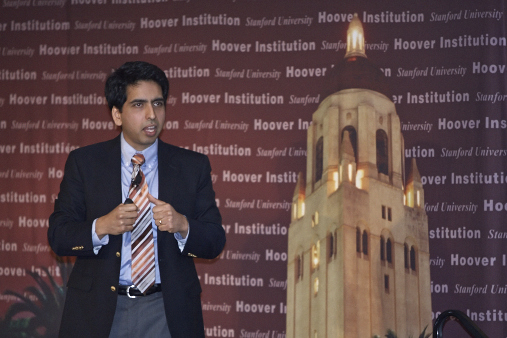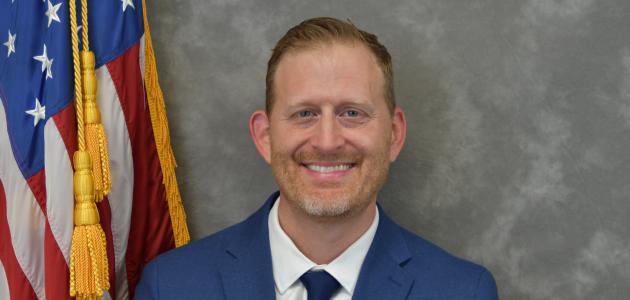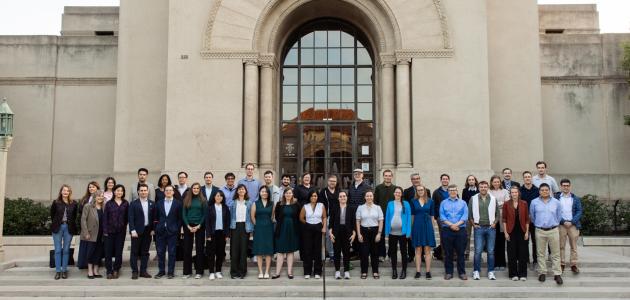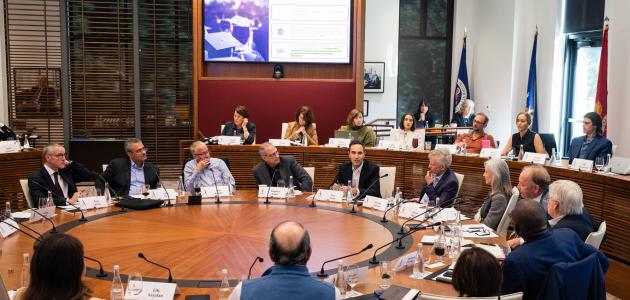
It began with concern over his faraway cousin’s problems with middle school math. Today, the initiative that Sal Khan started in August 2004 to help his cousin has grown into the Khan Academy, which reaches ten million users a month in nearly every country in the world.
Khan, the founder and executive director of the Khan Academy, gave the keynote address at the Hoover Institution’s symposium on Blended Learning in K–12 Education on January 16, 2014. Blended learning is the integration of classroom teaching with online lectures, exercises, and tutorials (such as those offered by the Khan Academy) that can viewed either at home or in the classroom at the student’s own pace.
Peppered with witty anecdotes and self-deprecating humor, Khan documented his journey from hedge fund analyst and part-time tutor to the creator of an Internet giant, and he laid out his vision for “education reimagined.”
By 2006, Khan had realized that by creating online tutorials, his befuddled young relatives in New Orleans could learn (and review) at their own pace, and he moved away from e-mails and phone calls and began uploading video tutorials on YouTube. With open access, his videos gained exposure and his audience expanded beyond friends and family. Sensing huge social benefits, he launched a nonprofit devoted to developing online tutorials from his closet home office.
Khan Academy (now with a content development team of more than fifty) has expanded beyond basic math, currently offering tutorials in calculus, trigonometry, computer science, engineering, general science, chemistry, biology, astronomy, economics, US history, art history, and more. Lessons are offered in a multitude of languages, including Spanish, French, German, Portuguese, Russian, Mandarin, Hindi-Urdu, Bengali, and Hebrew. He once thought, “Who knows, even one day it will be used in Mongolia.” Khan now proudly points to a fifteen-year-old Mongolian orphan who not only learns through the Khan Academy but provides content.
To internationalize the experience further, the Khan Academy has partners in Mexico, Brazil, Turkey, and France. Khan Academy is also extending beyond math and science—those subject areas most conducive to online learning—to the arts and humanities.
Originally viewed as supplementary to classroom instruction, his online videos “let you do things that can’t be done in a textbook, on a chalkboard,” for example, by displaying three-dimensional and rotating forms and diagrams. The Khan Academy was “never about replacing the physical classroom but always about trying to make the physical classroom more engaging, more human.”
By pairing the tools of machine learning “with an amazing teacher, amazing things can happen.” The Khan Academy has partnered with the Los Altos (CA) School District, Oakland (CA) Unity Academy, and Phillips Academy Andover (MA) to develop course modules and to design assessment tools. One such tool is the dashboard, which allows tracking of individual students and helps teachers identify students in need of extra help and, hence, to intervene early and to provide that additional help.
Khan Academy methods have been voluntarily adopted by some 150,000 teachers. With the data collected from teachers and students, Khan Academy is providing that data to help research on improving teaching and learning.
In the Khan Academy, students follow knowledge maps, advancing through levels of educational skills, just as they do in video games. As opposed to traditional education, where time is fixed and the knowledge gained is variable, students should master the material before moving on. In reimagining education, Khan feels that knowledge achievement should be fixed and the time necessary to learn should be variable.
Khan believes there is huge potential for people, if you let them tap into it. “The number-one goal of Khan Academy is … to give access to people to personalize their learning, for them to build a strong foundation to go as far as they want to go.” The majority of Khan Academy users are not traditional students but those trying to tap into their potential. Khan has numerous testimonials from high school dropouts, military veterans, and others who started on Khan Academy, embraced learning, and went on to finish college.
Khan seems always to extend his reach. When he had just a few dozen tutorials, he chose the grandiose name Khan Academy because it was available as a domain name. IRS forms require a very brief mission statement when applying for nonprofit status, so the Khan Academy’s lofty mission is to provide a “free world-class education for anyone, anywhere.”
He sees the digital learning explosion as a “special moment in history … [not] a once in a lifetime opportunity; literally once in a millennium; clearly an inflection point in history. Usually with inflection points they introduce opportunities and problems; with problems new opportunities: colonization of US, industrial revolution, Ivy League colleges, state college system. It may be delusional, but Khan Academy could be one of those institutions for the next stage.”
Khan’s presentation at the Hoover Institution
The two-day Hoover symposium on blended learning brought together classroom teachers, school administrators, content providers, and education researchers to examine the current status of blended learning in K–12 education, its degree of adoption and acceptance in traditional and charter schools, and its effectiveness.
Related stories:
Khan Academy is revolutionizing education
Hoover Conference Explores Blended Learning





















